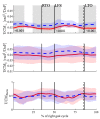Running-Induced Fatigue Changes the Structure of Motor Variability in Novice Runners
- PMID: 35741462
- PMCID: PMC9220051
- DOI: 10.3390/biology11060942
Running-Induced Fatigue Changes the Structure of Motor Variability in Novice Runners
Abstract
Understanding the effects of fatigue is a central issue in the context of endurance sports. Given the popularity of running, there are numerous novices among runners. Therefore, understanding the effects of fatigue in novice runners is an important issue. Various studies have drawn conclusions about the control of certain variables by analyzing motor variability. One variable that plays a crucial role during running is the center of mass (CoM), as it reflects the movement of the whole body in a simplified way. Therefore, the aim of this study was to analyze the effects of fatigue on the motor variability structure that stabilizes the CoM trajectory in novice runners. To do so, the uncontrolled manifold approach was applied to a 3D whole-body model using the CoM as the result variable. It was found that motor variability increased with fatigue (UCMꓕ). However, the UCMRatio did not change. This indicates that the control of the CoM decreased, whereas the stability was not affected. The decreases in control were correlated with the degree of exhaustion, as indicated by the Borg scale (during breaking and flight phase). It can be summarized that running-induced fatigue increases the step-to-step variability in novice runners and affects the control of their CoM.
Keywords: biomechanics; center of mass; motor control; uncontrolled manifold (UCM).
Conflict of interest statement
The authors declare no conflict of interest.
Figures


Similar articles
-
Influence of fatigue on running coordination: A UCM analysis with a geometric 2D model and a subject-specific anthropometric 3D model.Hum Mov Sci. 2019 Aug;66:133-141. doi: 10.1016/j.humov.2019.03.016. Epub 2019 Apr 11. Hum Mov Sci. 2019. PMID: 30981149
-
Stride-to-Stride Variability of the Center of Mass in Male Trained Runners After an Exhaustive Run: A Three Dimensional Movement Variability Analysis With a Subject-Specific Anthropometric Model.Front Sports Act Living. 2021 May 24;3:665500. doi: 10.3389/fspor.2021.665500. eCollection 2021. Front Sports Act Living. 2021. PMID: 34109313 Free PMC article.
-
The effects of different shoe stack heights and running speeds on full-body running coordination: An uncontrolled manifold analysis.J Biomech. 2025 Apr;183:112615. doi: 10.1016/j.jbiomech.2025.112615. Epub 2025 Mar 4. J Biomech. 2025. PMID: 40056729
-
Is There Evidence that Runners can Benefit from Wearing Compression Clothing?Sports Med. 2016 Dec;46(12):1939-1952. doi: 10.1007/s40279-016-0546-5. Sports Med. 2016. PMID: 27106555 Review.
-
Mechanics, energetics and implementation of grounded running technique: a narrative review.BMJ Open Sport Exerc Med. 2020 Dec 4;6(1):e000963. doi: 10.1136/bmjsem-2020-000963. eCollection 2020. BMJ Open Sport Exerc Med. 2020. PMID: 34422290 Free PMC article. Review.
Cited by
-
Changes in Key Biomechanical Parameters According to the Expertise Level in Runners at Different Running Speeds.Bioengineering (Basel). 2022 Oct 26;9(11):616. doi: 10.3390/bioengineering9110616. Bioengineering (Basel). 2022. PMID: 36354527 Free PMC article.
-
The effects of running shoe stack height on running style and stability during level running at different running speeds.Front Bioeng Biotechnol. 2025 Feb 21;13:1526752. doi: 10.3389/fbioe.2025.1526752. eCollection 2025. Front Bioeng Biotechnol. 2025. PMID: 40059889 Free PMC article.
-
Professional long distance runners achieve high efficiency at the cost of weak orbital stability.Heliyon. 2024 Jul 16;10(14):e34707. doi: 10.1016/j.heliyon.2024.e34707. eCollection 2024 Jul 30. Heliyon. 2024. PMID: 39130430 Free PMC article.
References
-
- Baldwin B. The State of Running. [(accessed on 26 September 2021)]. Available online: https://racemedicine.org/the-state-of-running-2019/
LinkOut - more resources
Full Text Sources

